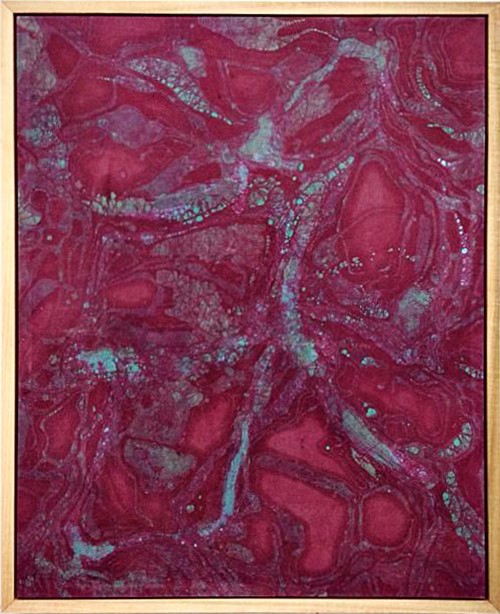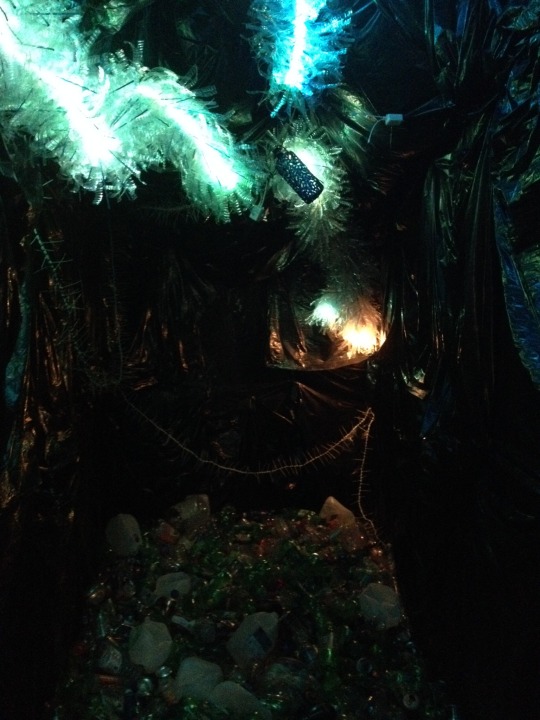Photo

Current Resident
Cassidy Frye
Junk Mail, Steel, Astroturf
Analysis By: Jo Banister
Identity and place tend to be important keys in an artist’s work – whether they realize it or not. Think of Judy Chicago or Robert Indiana and how their desire to tie their identity to a place led them to change their surnames in recognition of that place. By making “home” or “the roots” of a person out of junk mail, I believe the artist is calling into question whether places should hold such a sway over our identity – or at least, she is calling attention to the impermanence of physical places as markers of our identity. Further reading into the piece could draw out the thought that perhaps the artist is making a more metaphysical statement – maybe she is calling attention not just to the impermanence of a physical home, but also the impermanence of our physical bodies and pointing out that bodies as well as homes are something that will eventually deteriorate and decay.
#Cassidy Frye#Current Resident#Jo Banister#Art History#History Of now#Art#Original#Sculpture#Steel#Astroturf#Junk Mail#Moving#Home#Housing#Residency#herron school of art and design#analysis
0 notes
Photo

Improvisation by Ear; Batik
Gus Ayala
Analysis By: Tory Schendel
Improvisation by Ear by Gus Ayala is a whimsical work inspired by music. After attending two classical violin concerts, Ayala converted the lyrics of the instruments into a wax mixture on fabric. Adhering to the Indonesian traditional practices of “resist dyeing,” Ayala uses stark colors to reveal the tempo of the melody. In addition, the variant light and dark colors suggest the tone and pitch of each heard piece. Similar to the British abstract painter Alison Pilkington, her work Tango & Electronica emerged from her love of music. With the use of the canvas, Pilkington captures the spontaneous rhythms and sounds emitted from each song. Varying in musical genres ranging from Pop, Latin American, and Classical, Pilkington depicts an array of emotions evoked by music, noting “whether it’s joy, frivolity, passion or sadness.” In order to immerse one’s self in Pilkington’s artistic realm, Pilkington makes available a recording of the specific song that generated each individual piece. To feel the “Musical Interpretation,” a term coined by the artist, Pilkington suggests that when gazing upon Tango & Electronica, one must listen to Argentinian Tango music of Orquesta Del Plata. The work of Ayala and Pilkington provides a platform where art and music can share a dialog in the sense that each individual work functions as a visual aid; which intensifies the overall musical experience.
#Art#Batik#Painting#Original#Gus Ayala#Tory Schendel#Music#Improvisation By ear#Music interpretation#Herron School Of art and Design#History of Now#Art History#Analysis
1 note
·
View note
Photo


Desensitization and Realization
Anthony Schumann
Installation
Analysis By: Jacob Metzger
Desensitization and Realization is an installation in which Schumann has created a makeshift corridor lit by a sculpture comprised of recyclable materials like plastic bottles, street sweeper bristles, blinker bulbs, LED lights, and wire. The floor is littered with milk jugs, aluminum cans, and plastic bottles, which produce an overwhelming, cacophonous noise as one navigates the installation.
Entering the space is a difficult task. The corridor looks like a dystopian alleyway in a world where we are condemned to live among the excessive amounts of garbage we produce. The dead end of this bleak alleyway causes the audience to confront the unsustainability of their waste management practices by visually signaling that they are on a road to nowhere. The suffocating, claustrophobic installation goes beyond the literature our society is inundated with regarding the environment and recycling allowing the audience to have a more meaningful experience that may frighten them into making a change.
#Art#Installation#Recycled#Anthony Schumann#Jacob Metzger#Desensitization#Realization#Original#Sculpture#Herron School Of art and Design#Art History#History of Now
2 notes
·
View notes
Photo

Lotus
Sarah Surface
Analysis by Sarah Parkhurst
In this piece of art work, there are two hands that are in the center of the painting. They are forming a shape of a flower, and are pointing upward where there are ascending crystal formations. Throughout the painting the artist uses neutral colors, keeping the focus on the shape and form of the subjects. The painting sits inside of a deep frame, giving an intimate deep personal feeling to the artist. The artist invites the viewer to experience the form, neutral tone and message of the painting. After reading the artist statement and understanding the inspiration, there is a strong spiritual influence that is being portrayed in the painting.
#art#Sarah Surface#Sarah Parkhurst#print making#print#lotus#spiritual#art history#history#origianl#Herron School Of art and Design#crystal#hands
0 notes
Photo

Untitled
Kelsey Blacklock
Analysis By: Jo Banister
Immediately upon viewing this painting, I was drawn to the fact that the recognizable figure in the piece is shown only partially with their back to the viewer. This composition technique, whether conscious or not, mirrors the Romanticist concept of the Rückenfigur to me. The Rückenfigur is a lone figure shown with their back to the viewer, normally shown contemplating a landscape view. The figure is meant to force the viewer into seeing the view from that figure’s point of view – in the case of Romanticist landscape, to force the viewer into a sublime experience drawn from nature. This piece takes the idea of a Rückenfigur and brings it into a contemporary setting. Instead of the viewer feeling the loneliness and longing for nature in a sweeping landscape, the viewer is made to contemplate the unnatural, the mechanical, or the modern and how even without the natural beauty of a landscape, the figure is still an isolated person longing for some experience that takes them outside of the loneliness of their isolation.
#Kelsey Blacklock#Jo Banister#Art#Painting#canvas#herron school of art and design#Art History#Social#Viewer Feeling#Lonliness#History of now
1 note
·
View note
Photo

Americana Chair
Grant Keeney
Analysis By: Jo Banister
I think that this piece shows an interesting intersection between fine craftsmanship and the long history of reusing or recycling found materials. The phrase “found object art” normally brings to mind outsider artists like Thornton Dial whose canvases are chaotically populated with spray painted Barbie dolls, bits of fabric, box springs, twigs, etc. This chair present a kind of “high craft” found object art – by using a discarded material (animal hide), the artist has shown a side of reuse or recycle that is informed by a furniture maker’s attention to craftsmanship and detail.
#Art#Grant Keeney#Jo Banister#Analysis#Furniture Design#Americana Chair#Chair#Furniture#handmade#craft#hide#cow#wood#herron school of art and design#Art History#History of Now
1 note
·
View note
Photo

Security Blanket
Cassidy Frye
Wood, hand-dyed fabric, batting.
Analysis By: Alexandra Makris
Security Blanket by Cassidy Frye consists of a constructed frame of the basic wooden underpinning of a house resting on a hand-dyed quilt of cool colors. The structure of the framework creates negative spaces of triangles and rectangles, reinforcing the overall sense of stability. Quilts themselves are symbols of comfort as well as art objects in American culture, and the soft fabric of the blanket broken down into rectangular shapes of calming colors provide a temperature contrast against the stable, but bare, framework of a house. Though a house is not always a home, the frame provides a basis for the intangible feelings to develop through. Another reason for the inclusion of the quilt is that the soft portion of this work is something easily packed up and taken with someone, while the physical interior of a house is simply a place for the quilt to rest. The movable quality is not limited to the quilt, as the house itself is not cemented down. Therefore the work easily becomes the vehicle for the image of new starts and beginnings, with memories and old beginnings creating an integral part of the new structure.
#Cassidy Frye#Security Blanket#Sculpture#Alexandra Makris#Moving#Home#Structure#Quilt#Hand-dyed#Movable#Housing#Wood#Art History#History Of Now
1 note
·
View note
Photo

No Outlet
Gus Ayala
Oil on canvas
Analysis By: Tory Schendel
No Outlet by Gus Ayala depicts a dysfunctional relationship between two parental figures. The grim background colors set the overall tone of the piece. The layering of red and black generates an instantaneous mood of frustration, anger and extreme melancholy. On the right side, a male figure is placed in the corner of the painting. His furrowed eyebrows and inactive posture illustrates a lack of interest. With his head curled toward his right shoulder, he seems not only displeased, but disgusted in his current environment. Shifting to the left, a woman is seen. As she grips her hands, she appears exceptionally uncomfortable. Her tense shoulders and scowl expression denotes a state of sorrow and pain. In between both figures, a white table runner is present. Its placement and stark color juxtaposes the rift between both figures. Acting as a wall, neither person looks at one another. Not only is this scene uneasy, but it is a direct viewpoint into the current marriage trend in America. Since the 1970’s, divorce rates have excelled well-above 70%. Currently experiencing a failing marriage, Ayala uses his parents as the subjects within this painting. The title, No Outlet, suggests that there is no hope for his parents; however, there is an alternate interpretation. Even though the table runner acts as a barrier between both parents, the runner leads the viewer to the painting on the wall. As read in Dante’s Divine Comedy a “straight path” only leads to salvation. Thus, the depiction of a straight path on the wall indicates that the marriage can be saved through moral perseverance. 7
#Gus Ayala#Tory Schendel#No Outlet#Painting#Oil on canvas#herron school of art and design#Art History#History of now#Analysis#Tense#Relationship#Background#Roots
0 notes
Photo

Desk
Aleya Lanteigne
Analysis by Vickie Stone
Few art pieces are made to be ephemeral, so museum collection managers spend their careers taking care of objects to preserve the original form of a piece in perpetuity. Wood pieces, such as Lanteigne’s desk, pose several particular challenges when it comes to preservation. The first is lighting can severely alter or damage organic materials. Even though this desk is lightly colored wood, exposure to ultraviolet light can cause discoloration over time. To best preserve this piece for as long as possible, monitoring its time on exhibition and rotating the piece in and out of dark storage areas could decrease light exposure over time.
Another major problem when taking care of wood for an extended period of time is managing pests that are attracted to wood. Termites and other wood boring insects can eat away at the structure of the piece. The best practice is to set up pest traps close to the piece if it is in storage and to monitor for pest activity if the piece is on exhibition display.
Collection managers should also control, as best as possible, the temperature and humidity levels of the storage and exhibition areas of the piece. Wood can develop mildew or mold if exposed to moisture which can lead to damage on the piece itself or lead to the spread of these fungi to other objects. Dust also can cause damage by abrading the surface over time. Laneigne’s piece has three open compartment spaces that could collect dust easily, so regular cleaning could keep dust from accumulating and causing abrasion damage.
The job of a collections manager is to keep the art piece in the same state that the artist intended so that the piece can be enjoyed for generations. Mitigating potential problems are some of the best practices to ensuring the longevity of the art piece.
#Art#Aleya Lanteigne#Furniture Design#herron school of art and design#Vickie Stone#Museum Studies#Art History#History of now#Analysis#Wood#Desk#Furniture#Copper#Raw
2 notes
·
View notes